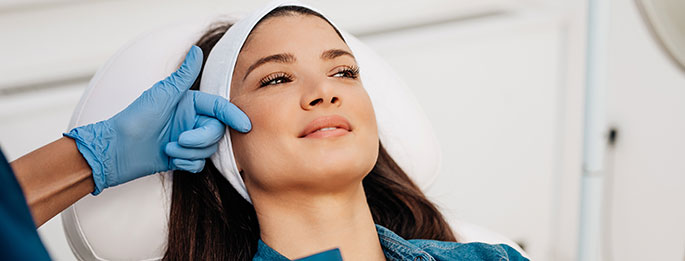Aesthetic Medicine
Learn everything about aesthetic medicine: the concerns it addresses, the most common treatments, and the most effective techniques used, along with some recommendations to help you prepare for your sessions. Book an appointment with one of our aesthetic medicine specialists at any of our centers.

What is aesthetic medicine?
Aesthetic medicine is a medical discipline focused on the restoration, maintenance, and enhancement of aesthetics, health, and well-being. This specialty employs non-invasive or minimally invasive techniques to achieve natural and long-lasting results.
Aesthetic medicine treatments improve patients’ physical appearance without the need for general anesthesia or hospital stays. In most cases, individuals can resume their routines immediately or within a few days.
The main goals of aesthetic medicine are to improve facial and body appearance, enhance skin quality, minimize the effects of aging, and promote cellular regeneration. Ultimately, it aims to improve how patients perceive themselves, thereby enhancing their quality of life.
H2: What does aesthetic medicine study?
Aesthetic medicine addresses a wide range of concerns and is therefore divided into different areas of focus:
- Facial aesthetic medicine: focuses on enhancing and rejuvenating the face.
- Body aesthetic medicine: aims to improve physical appearance across all areas of the body, primarily restoring skin condition and reducing localized fat.
- Aesthetic dermatology: specializes in skincare to maintain smooth, hydrated, and blemish-free skin.
- Hair medicine: deals with the health of the hair and scalp, as well as hair removal from various areas of the body.
Who is it for?
Aesthetic medicine is intended for anyone looking to improve their appearance while maintaining a natural look and who prefers to avoid surgical procedures.
Techniques, Procedures, and Diagnostic Methods
At Quirónsalud, we are well-versed in the most innovative techniques in aesthetic medicine to meet our patients’ needs. Some of the most in-demand procedures include:
- Lip augmentation: performed by injecting a filler substance—typically hyaluronic acid—into specific areas using needles or cannulas after applying a topical anesthetic. The result is fuller, more defined lips.
- Non-surgical rhinoplasty: involves reshaping the nose through hyaluronic acid injections. It can lift the tip, correct dorsal humps, or straighten the nasal bridge.
- Under-eye filler: small amounts of hyaluronic acid are injected to fill shallow grooves under the lower eyelid, as well as to hydrate and tighten the skin.
- Microneedling radiofrequency: uses electrocoagulation to stimulate collagen production in both the face and body. It's highly effective for rejuvenating, redefining, and tightening the skin.
- Mesotherapy: involves injecting a blend of medications with fine needles to promote lymphatic drainage and improve microcirculation. It’s effective in reducing cellulite and minimizing signs of aging on the face.
- Thread lifts: threads (either permanent or absorbable) are inserted under the skin using cannulas or needles, stimulating collagen and elastin production. This results in facial rejuvenation.
- Collagen stimulators: substances such as calcium hydroxyapatite or polylactic acid are injected to encourage collagen production, visibly improving skin firmness.
- Carboxytherapy: involves CO₂ injections to enhance cellular oxygenation and fat reduction. It is used for facial rejuvenation, reducing sagging, eliminating localized fat, lightening dark circles, and treating cellulite.
- Intralipotherapy: also known as non-surgical liposuction, it targets localized fat using deoxycholic acid injections.
- Chemical facial peel: acids are used to remove the skin’s outer layer, encouraging regeneration and treating wrinkles, fine lines, blemishes, and discoloration.
The most commonly used substances in aesthetic medicine treatments include hyaluronic acid, botulinum toxin (Botox), platelet-rich plasma (PRP), calcium hydroxyapatite, and vitamins.
Diseases and symptoms
Common Conditions and Concerns
Some of the most frequently treated aesthetic concerns in this specialty include:
- Cellulite: uneven fat deposits commonly found on the thighs, hips, and abdomen.
- Stretch marks: irregular lines on areas like the thighs, abdomen, buttocks, and breasts caused by rapid skin stretching.
- Skin lesions, blemishes, or discoloration from aging, sun exposure, erosions, scarring, acne, or infections.
- Dark circles and eye bags.
- Wrinkles and expression lines.
- Facial sagging.
- General signs of aging.
- Excessive sweating.
- Localized fat.
- Facial disharmony.
Related Symptoms
Patients who seek aesthetic medicine treatments often experience symptoms such as:
- Deterioration in skin quality
- Skin dehydration
- Inflammation
- Poor elasticity
- Loss of facial contour
- Blurred facial structure
- Volume loss in the face
- Tired appearance
- Redistribution of body fat
- Excessive hair growth
Low self-esteem
About the aesthetic medicine consultation
We solve any doubts you may have before you see the specialist
The first aesthetic medicine consultation involves an initial assessment to evaluate the patient’s condition and needs. During the anamnesis, information is gathered regarding:
- Medical and surgical history
- Current and past treatments
- Family history of genetic conditions
- Habits and lifestyle
- Expectations
This is followed by a physical examination to analyze the patient’s features and assess whether their goals are achievable. Finally, a detailed treatment plan is presented.
In some cases, treatment may be administered during the same visit. However, most often, a follow-up appointment will be scheduled to carry out the procedure.
What should you keep in mind?
Aesthetic medicine includes a wide range of treatments designed to address different needs. However, it's important to manage expectations and understand the limitations of both the therapies and the body itself.
To achieve the best results, it's advisable to maintain a healthy diet, stay well-hydrated, exercise regularly, and reduce harmful habits like alcohol and tobacco use. Additionally, patients should follow the post-treatment instructions provided by the specialist.
Although aesthetic medicine treatments can be performed year-round, special care should be taken regarding sun and heat exposure. For facial procedures in particular, it is often recommended to avoid summer months.
What should I bring to the consultation?
To make the most of your consultation, it's helpful to bring a list of your medical history, current treatments, and known allergies. You should also have a clear idea of your goals and, in the case of treatments that may alter facial harmony, the reasons behind your interest in the procedure.
If you’ve already done some research on the treatment, write down all your questions to ensure they are answered before proceeding.

If you have any further questions, please contact us through the Patient Services telephone number: 900 301 013














































